20世紀初頭、パリで花開いたフォーヴィスム、キュビスム。しかし、その芸術の潮流はフランスだけに留まらず、ドイツ、イタリア、ロシアへと波及し、それぞれの地で独自の進化を遂げました。
ドイツでは画家の内面を強烈に表現する「表現主義」が、イタリアではスピードとダイナミズムを追求する「未来派」が、そしてロシアでは前衛的な「ダイヤのジャック」や「構成主義」が誕生しました。
これらの芸術運動は、一見すると異質なように見えますが、内面世界の探求という共通のテーマを抱えていました。
本記事では、ポンピドゥー・センターが誇るコレクションの中から、これらの芸術運動を代表する画家たちの作品を厳選してご紹介します。
カンディンスキー、キルヒナー、クレー、セヴェリーニなど、時代を切り拓いた巨匠たちの作品を通して、20世紀初頭の芸術の熱狂と革新を体感してください。
German Expressionism ドイツ表現主義
ドイツ表現主義は、20世紀初頭にドイツを中心に起こった芸術運動です。印象主義や自然主義に対する反動として、画家の内面的な感情や精神性を主観的に表現することを重視しました。
特徴:
- 感情の強調:
- 不安、苦悩、情熱など、人間の内面的な感情を強烈な色彩や歪んだ形態で表現。
- 主観的な表現:
- 客観的な現実の描写よりも、画家の主観的な解釈や感情を重視。
- 形態の変形:
- 対象の形態を大胆に変形させ、感情や精神性を強調。
- 強烈な色彩:
- 感情を表現するために、鮮やかで対照的な色彩を多用。
- 社会批判:
- 当時の社会の矛盾や不安を批判的に表現する作品も多く見られる。
Alexej von Jawlensky (1865-1941)
アレクセイ・フォン・ヤウレンスキー(1865-1941)は、ロシア帝国出身のドイツで活躍した表現主義の画家です。
特徴:
- 鮮やかで力強い色彩と、単純化された形態による人物表現が特徴です。
- ゴッホ、ゴーギャン、マティスなどから影響を受け、独自の表現を確立しました。
- カンディンスキーやマリアンヌ・フォン・ヴェレフキンらと親交が深く、「青騎士」グループにも参加しました。
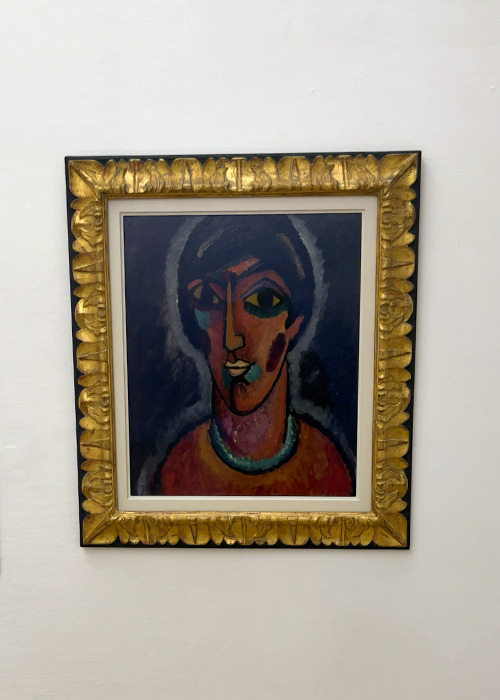
Byzantinerin (Helle Lippen) (Byzantine (Lèvres pâles)) (1913)
「Byzantinerin (Helle Lippen)」(ビザンチン女(明るい唇))は、1913年に制作された彼の代表的な作品の一つです。
ビザンチン美術のイコンを思わせる、神秘的で精神性の高い人物像が描かれています。
鮮やかで力強い色彩が用いられており、特に明るい唇が印象的です。
Ernst Ludwig Kirchner (1880-1938)
エルンスト・ルートヴィヒ・キルヒナー(1880-1938)は、ドイツ表現主義を代表する画家の一人です。
特徴:
- 強烈な色彩と大胆な形態:
- 感情を強烈に表現するために、鮮やかで対照的な色彩と、対象を大胆に変形させた形態を用いました。
- 都市生活の表現:
- ベルリンなどの都市生活における孤独や不安、緊張感などを表現した作品を多く残しました。
- 版画制作:
- 絵画だけでなく、版画制作にも力を入れ、多くの優れた作品を残しました。
- 社会批判:
- 当時の社会の矛盾や不安を、鋭い視点で批判的に表現した作品も多く見られます。
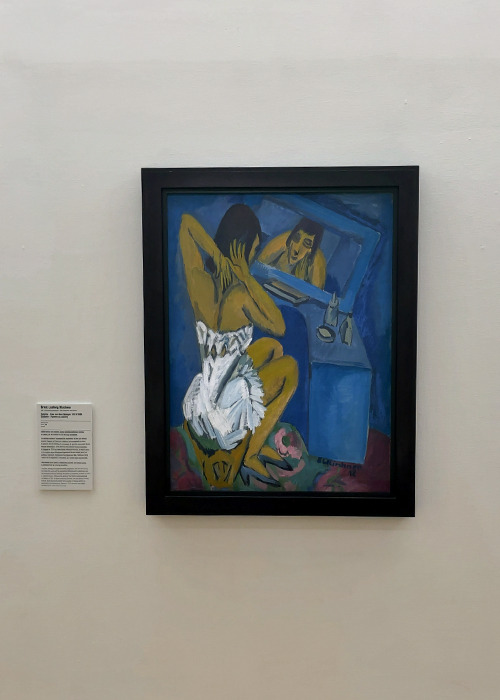
Toilette – Frau vor dem Spiegel (La toilette – Femme au miroir) (1920)
「Toilette – Frau vor dem Spiegel (La toilette – Femme au miroir)」(化粧 – 鏡の前の女性)は、1920年に制作された彼の代表的な作品の一つです。
青を中心とした背景に、歪んだ遠近法、モデルのポーズが鏡に映ったものと違うなど様々な手法を取り入れて描かれています。
女性の孤独や不安、あるいは官能性が表現されていると考えられます。
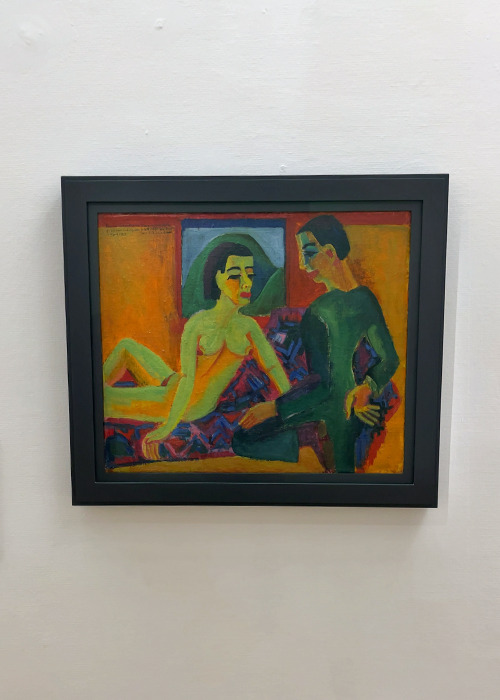
Liebespaar (Les Amoureux) (1921 – 23)
「Liebespaar (Les Amoureux)」(恋人たち)は、非常にシンプルな構図で描かれています。
恋人たちの表情や身振りを通して、愛情や親密さといった感情が繊細に表現されています。
Max Pechstein (1881-1955)
マックス・ペヒシュタイン(1881-1955)は、ドイツ表現主義の画家であり、特に「ブリュッケ」(橋)グループの主要メンバーの一人として知られています。
特徴:
- 力強い色彩と原始的な形態:
- 強烈な色彩と、原始美術から影響を受けた単純化された形態が特徴です。
- タヒチ旅行の経験から、エキゾチックな主題や原始的な表現に魅了されました。
- 装飾的な表現:
- 装飾的な要素を取り入れた作品も多く、工芸的な才能も発揮しました。
- 版画制作:
- 絵画だけでなく、版画制作にも力を入れ、多くの優れた作品を残しました。
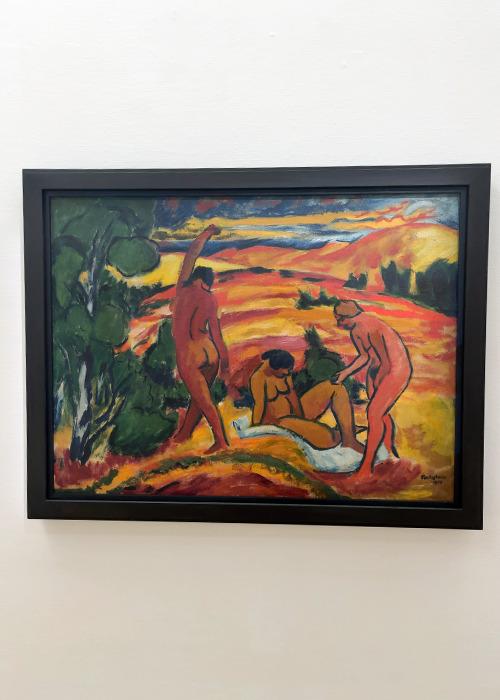
In den Dünen (Dans les dunes) (1911)
「In den Dünen (Dans les dunes)」(砂丘にて)は、ゴーギャンを思わせるような作品です。
砂丘の風景の中に裸体の人物を描くことで、自然と人間の調和を表現しています。
人物は自然の中に溶け込むように描かれており、原始的な生命力が感じられます。
New Objectivity 新即物主義
新即物主義(しんそくぶつしゅぎ)は、第一次世界大戦後のドイツで興った芸術運動です。表現主義の主観的な感情表現への反動として、客観的で冷静な現実描写を追求しました。
特徴:
- 客観的な現実描写:
- 感情や主観を排し、現実をありのままに描写することを目指しました。
- 社会や人間の姿を、冷徹な視点で捉える作品が多く見られます。
- 社会批判:
- 当時の社会の矛盾や問題を、辛辣な風刺や批判を込めて表現しました。
- 戦争や社会不安による人々の荒廃した姿などを、容赦なく描き出しています。
- 写実的な表現:
- 細密な描写や正確な形態把握など、写実的な表現技法を用いました。
- 現実の細部まで克明に描き出すことで、作品に強いリアリティを与えています。
Otto Dix (1891-1969)
オットー・ディクス(1891-1969)は、第一次世界大戦後のドイツで活躍した画家であり、新即物主義の代表的な作家の一人です。
新即物主義は、表現主義に反するもので、社会の中の無名・匿名として存在している人間に冷徹的な視線で即物的に表現する運動のことになります。
ナチスの台頭により、退廃芸術として運動は衰退していきます。
特徴:
- 冷徹な現実描写:
- 戦争の悲惨さや社会の矛盾を、容赦ない写実的な描写で表現しました。
- 感情を排し、客観的な視点で現実を捉えることを重視しました。
- 社会批判:
- 当時の社会の腐敗や退廃を、辛辣な風刺を込めて描き出しました。
- 戦争による人々の荒廃した姿や、社会の暗部を克明に描写しています。
- 写実的な技法:
- 細密な描写や正確な形態把握など、写実的な表現技法を駆使しました。
- 現実の細部まで克明に描き出すことで、作品に強いリアリティを与えています。
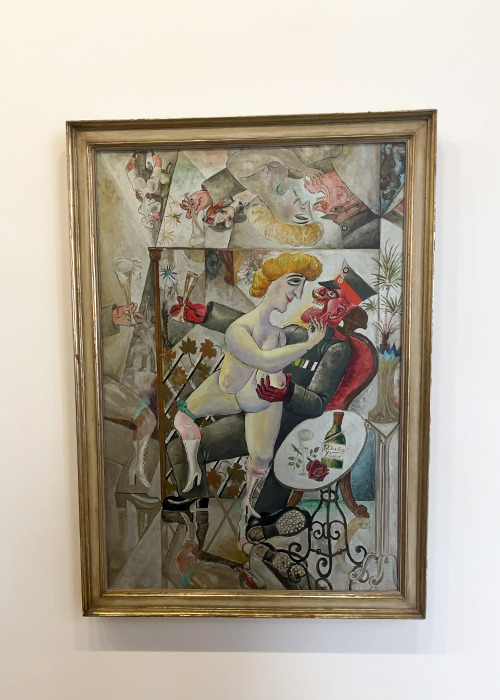
Erinnerungen an die Spiegelsäle von Brüssel
(Souvenirs de la galerie des glaces à Bruxelles)
(1920)
「Erinnerungen an die Spiegelsäle von Brüssel 」(ブリュッセルの鏡の間の思い出)は、1920年に制作された彼の代表的な作品の一つです。
第一次世界大戦後の社会の退廃や腐敗を、辛辣な風刺を込めて表現しています。
細密な描写や正確な形態把握など、写実的な表現技法を駆使しています。
登場人物の姿はグロテスクに歪められており、社会の病んだ雰囲気を強調しています。
Der blaue Reiter 青騎士
「青騎士」(Der Blaue Reiter)は、20世紀初頭のドイツで活動した芸術家グループです。
概要:
- 1911年、ヴァシリー・カンディンスキーとフランツ・マルクを中心に、ミュンヘンで結成されました。
- 表現主義の画家たちによる緩やかなグループで、特定の様式にこだわらず、自由な芸術表現を追求しました。
- 絵画だけでなく、音楽、演劇、舞踊など、さまざまな芸術分野との交流を重視しました。
- 1912年には、同名の芸術年鑑『青騎士』を刊行し、グループの理念や作品を発表しました。
- 第一次世界大戦の勃発により、1914年に活動を停止しました。
特徴:
- 精神性の重視: 物質的な現実よりも、内面的な感情や精神性を表現することを重視しました。
- 抽象絵画の先駆: カンディンスキーを中心に、抽象絵画の発展に大きく貢献しました。
- 色彩の重視: 色彩を感情や精神性を表現するための重要な要素として捉え、鮮やかで力強い色彩を多用しました。
- 多様な芸術の融合: 絵画だけでなく、音楽、演劇、舞踊など、さまざまな芸術分野との交流を重視し、総合的な芸術表現を目指しました。
Vassily Kandinsky (1866-1944)
ヴァシリー・カンディンスキーは、19世紀末から20世紀にかけて活躍したロシア出身の画家であり、抽象絵画の創始者の一人として知られています。
主な特徴:
- 抽象絵画の創始者:
- 従来の具象絵画から脱却し、色と形のみで感情や精神性を表現する抽象絵画を確立しました。
- 「絵画における精神的なもの」などの著作で、自身の理論を展開し、後世の芸術家に大きな影響を与えました。
- 色彩と形の表現:
- 色彩と形に象徴的な意味を与え、音楽のように感情を直接的に表現しようとしました。
- 特に、黄色、青、赤の三原色を重視し、それぞれの色が持つ感情的な効果を探求しました。
- 多様な作風の変遷:
- 初期は印象派やフォービズムの影響を受けましたが、次第に抽象的な表現へと移行しました。
- 「印象」「即興」「コンポジション」といった独自のカテゴリーで作品を分類し、それぞれの段階で異なる抽象表現を試みました。
- バウハウス時代には、幾何学的な形を用いた作品を多く制作し、晩年にはより自由で幻想的な表現へと回帰しました。
- 「青騎士」グループ:
- フランツ・マルクとともに「青騎士」グループを結成し、表現主義の運動を推進しました。
- 「青騎士年鑑」を刊行し、同時代の芸術家たちと交流しながら、新しい芸術の可能性を探求しました。
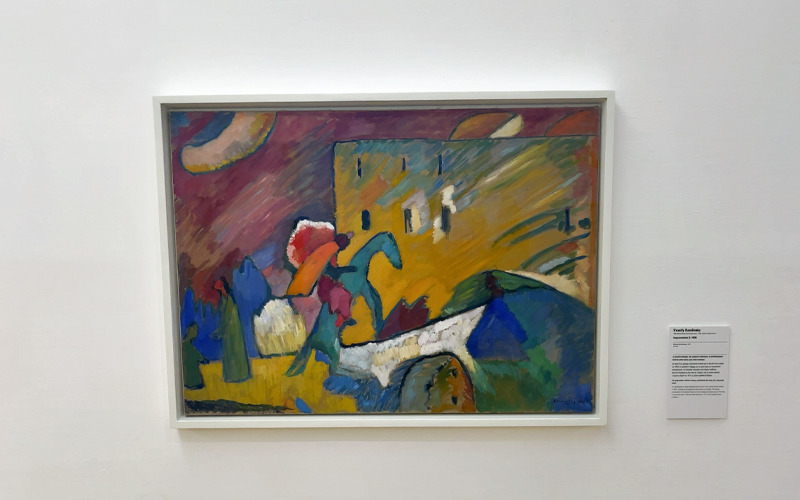
Improvisation 3 (1909)
「Improvisation 3 (1909)」は、カンディンスキーが抽象絵画へと移行していく初期の段階に制作されたものであり、彼の芸術的な探求を示す重要な作品の一つです。
チュニスの街の橋を、馬と騎手が上に向かって進んでいます。騎手は聖ジョージ(自分自身)をイメージしています。
作品の特徴:
- 即興的な表現:
- タイトルにある「Improvisation(即興)」は、カンディンスキーが音楽の即興演奏から着想を得て、感情や内面を自由に表現しようとしたことを示しています。
- この作品では、具体的な対象を描写するのではなく、色彩や形、線などが自由に配置され、音楽のようなリズムや感情の流れが表現されています。
- 色彩の表現:
- カンディンスキーは、色彩に象徴的な意味を与え、感情を直接的に表現しようとしました。
- 「Improvisation 3」でも、鮮やかな色彩が用いられ、感情の高まりや精神的な興奮が表現されています。
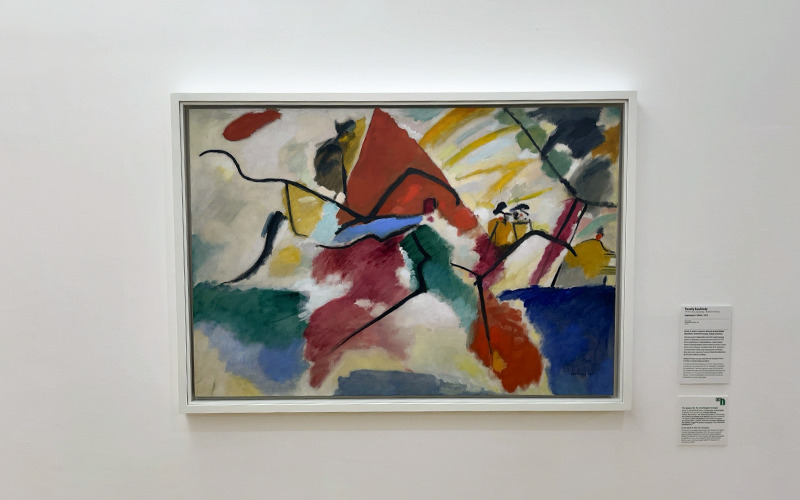
Impression V (Parc) (1911)
タイトルにある「印象」は、カンディンスキーが自然から受けた印象を、感情や色彩を通して表現しようとしたことを示しています。 この作品では、公園という自然の風景が題材となっていますが、具体的な描写ではなく、色彩や形によって感情や雰囲気が表現されています。
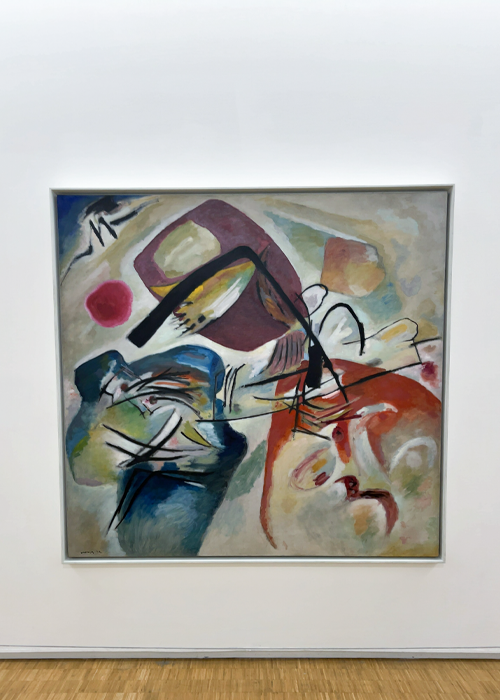
Mit dem schwarzen Bogen (Avec l’arc noir) (1912)
衝突する3つの大陸をロシアの伝統的な馬具である「ドゥーガ」にインスピレーションを得た黒い弓によって緊張状態を保っています。
黒い弧を中心に、様々な色彩や形が自由に配置され、音楽のようなリズムや感情の流れが表現されています。
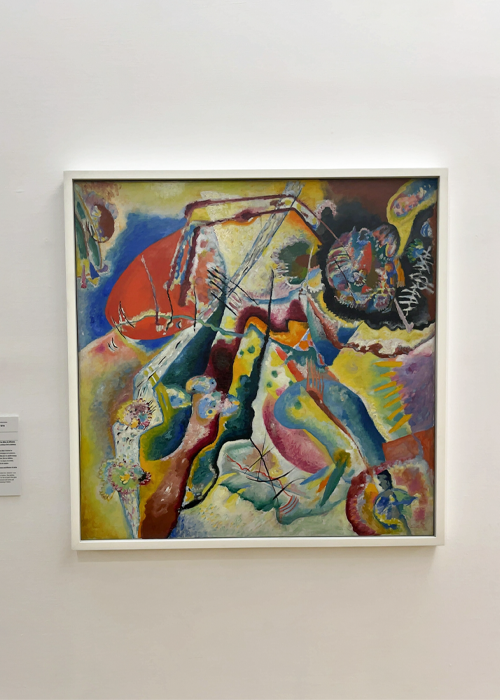
Bild mit rotem Fleck (Tableau à la tache rouge) (1914)
「Bild mit rotem Fleck (Tableau à la tache rouge) (1914)」(赤い斑点のある絵)は、赤い斑点を中心に、様々な色彩や形が自由に配置され、音楽のようなリズムや感情の流れが表現されています。
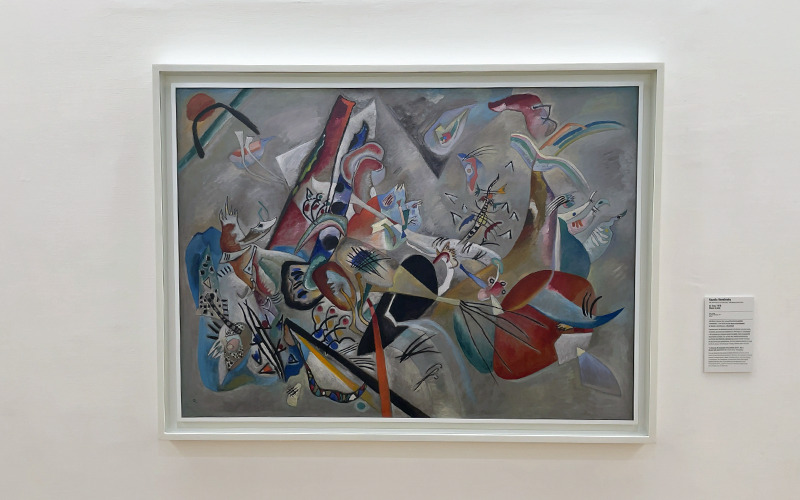
Im Grau (Dans le gris) (1919)
「Im Grau (Dans le gris) (1919)」(灰色の中に)は、ロシア革命後のモスクワで制作した、ロシア時代最後の作品の一つです。
灰色を基調としながらも、赤や青、黄などの鮮やかな色彩が用いられ、感情の複雑さや深みが表現されています。
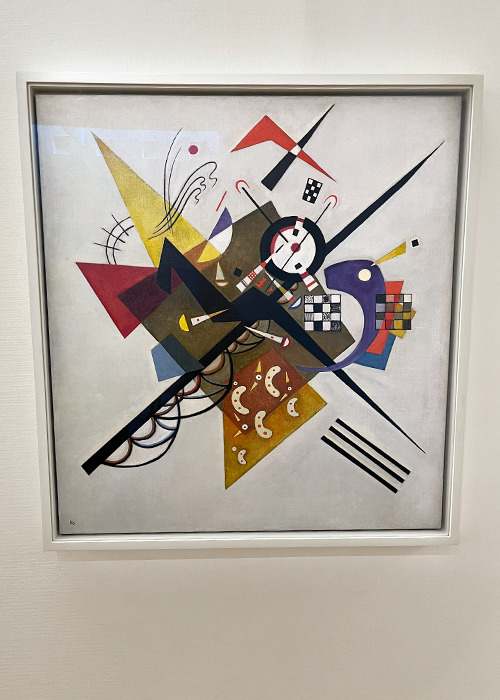
Auf Weiss II (Sur blanc II) (1923)
「Auf Weiss II (Sur blanc II)」(白の上のII)は、バウハウス時代のアパートのダイニングに飾られていた作品になります。
白い背景の上に、様々な幾何学的な形や線、色が配置されています。形と色の相互作用によって、音楽のようなリズムと空間を生み出すことを意図しています。
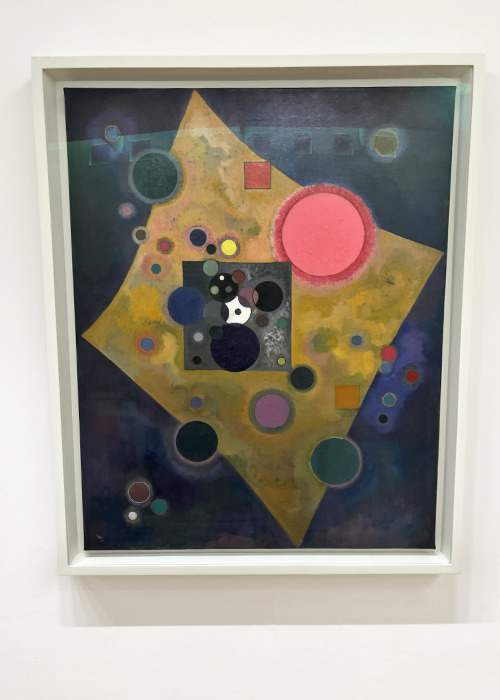
Akzent in Rosa (Accent en rose) (1926)
「Akzent in Rosa (Accent en rose)」(ピンクのアクセント)は、バウハウス時代の作品になります。
ピンク色を中心に、さまざまな形と色が緻密に配置されています。 形と色の相互作用によって、独特の空間とリズムが生み出されています。
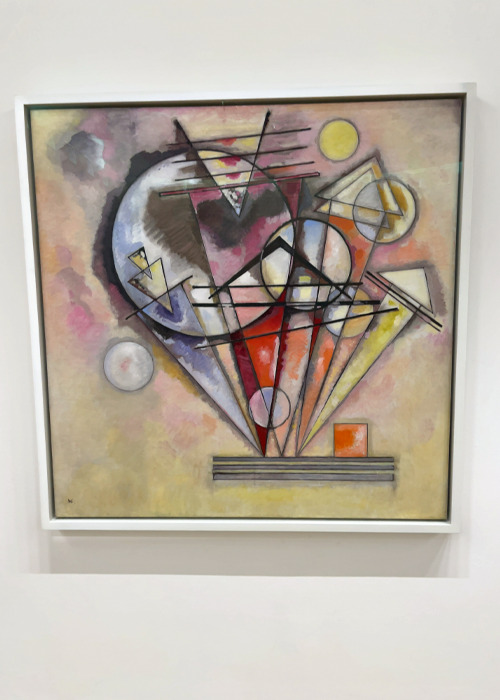
Auf Spitzen (Sur les pointes) (1928)
「Auf Spitzen (Sur les pointes)」(尖端の上で)は、1926年に出版された「Point and Line to Plane(平面上の点と線)」の図法に基づいて描かれています。
水彩画のように扱われた色彩が、作品から軽やかさと無重力の印象を与えることに貢献しています。
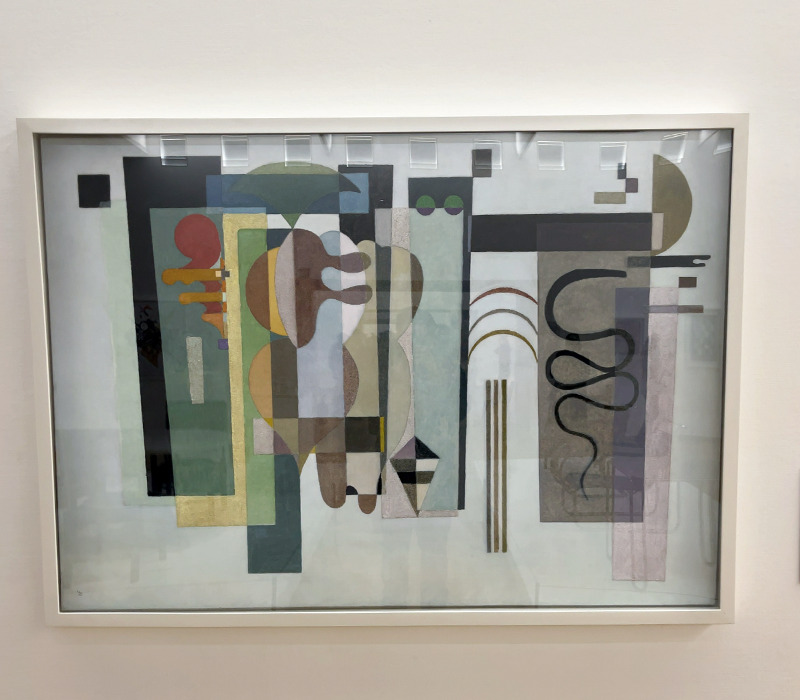
Deux points verts (1935)
「Deux points verts (1935)」(二つの緑の点)は、画面の上部中央にある二つの小さな緑色の点が、作品のタイトルにもなっています。
この作品は、バランス、リズム、そして正と負の空間の相互作用といったテーマを探求しているようです。
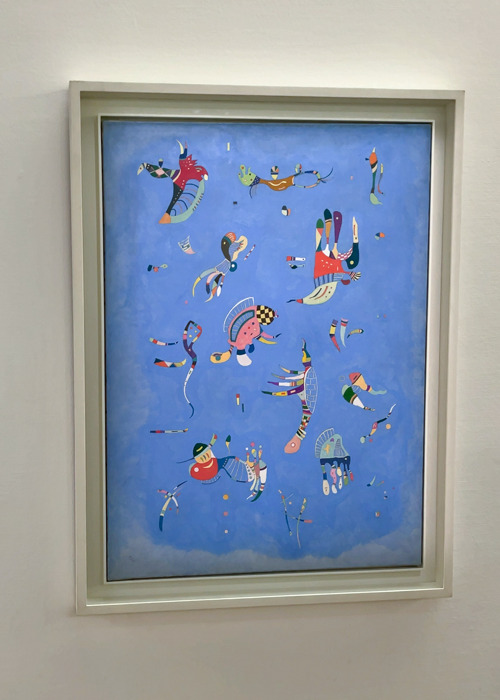
Bleu de ciel (1940)
「Bleu de ciel (1940)」(空色)は、占領下、ヌイイ=シュル=セーヌのアパートで描かれた作品です。
空色を中心とした色彩と形によって、見る人の心に安らぎや希望を与えることを意図していると考えられます。
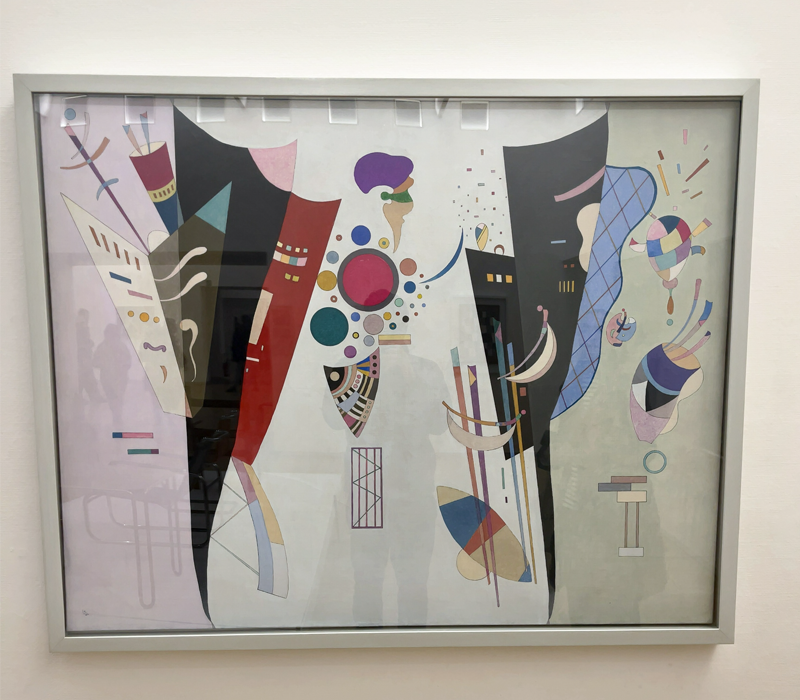
Accord réciproque (1942)
「Accord réciproque (1942)」(相互協定)は、カンディンスキー、最後から2番目の作品になります。
曲線が巧みに配され、螺旋を思わせる流動感が生み出されているところは、同時期の作品の中で、この作品をよりユニークなものにしています。
画面の地をつかさどる赤をはじめ、暖色と対照的な白が基調をなしている点も特色となります。
色と音をキャンパスに描く集大成と呼べる作品になっています。
Lyonel Feininger (1871-1956)
リオネル・ファイニンガーは、ドイツ系アメリカ人の画家です。
- 生い立ちと初期の活動:
- ニューヨークでドイツ人の音楽家の両親のもとに生まれ、幼少期から音楽と美術に親しみました。
- ドイツで美術を学び、初期には風刺画家として活躍しました。
- 作風の確立とバウハウス:
- キュビスムや未来派の影響を受け、独特の幾何学的で透明感のある作風を確立しました。
- 青騎士のメンバーであり、1919年からバウハウスで教鞭をとり、パウル・クレーやワシリー・カンディンスキーらと交流しました。
- 教会の連作は、彼の代表的な作品群として知られています。
- 晩年と評価:
- ナチスの台頭によりアメリカに帰国し、晩年はアメリカで制作活動を続けました。
- 彼の作品は、建築的な構造と光の表現が特徴であり、20世紀美術において独自の地位を築いています。
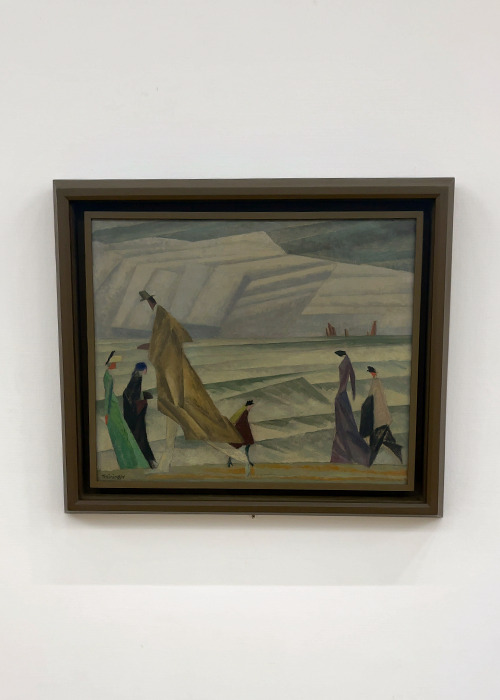
Am Strande (Sur la plage) (1913)
「Am Strande (Sur la plage)」(海岸にて)は、海岸の風景を、幾何学的な形と透明感のある色彩で描いています。
建物、海、空などが、三角形や四角形などの単純な形に分解され、再構成されています。
光の表現が特徴的で、画面全体に独特の明るさと透明感を与えています。
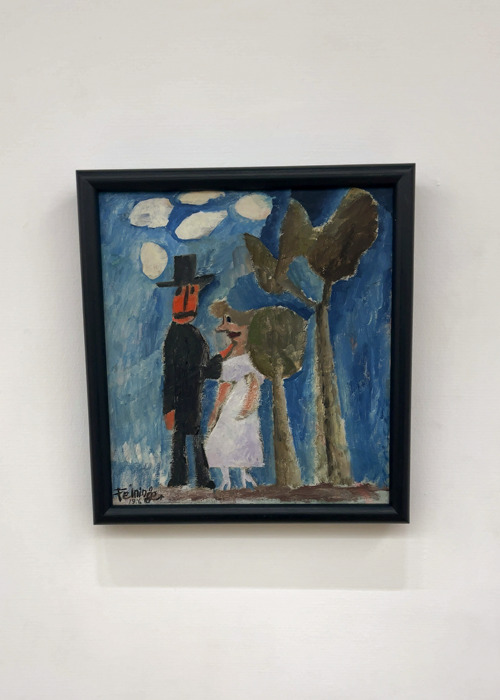
Liebespaar (Les amoureux) (1916)
「Liebespaar (Les amoureux)」(恋人たち)は、キュビスムの影響を受けた作風が特徴です。恋人たちを、幾何学的な形と透明感のある色彩で描いています。人物、木などが、三角形や四角形などの単純な形に分解され、再構成されているのが特徴です。
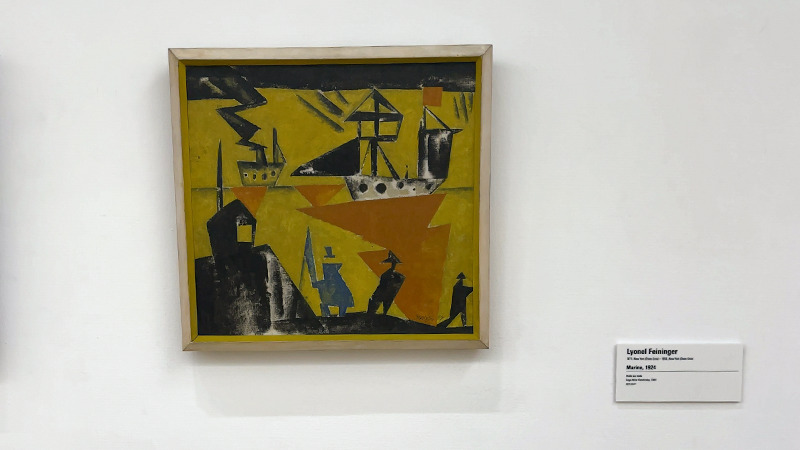
Marine (1924)
「Marine (1924)」(海景)には、貨物船やヨットが描かれています。
海の風景を、彼の内面的な視点を通して再構築することで、新しい絵画表現を追求しています。
リオネル・ファイニンガーは「海」をテーマにした作品を多く描いています。
Gabriele Münter (1877-1962)
ガブリエレ・ミュンターは、ドイツ表現主義の画家であり、青騎士(ブラウエ・ライター)のメンバーとしても知られています。最後まで青騎士のスタイルを残していました。
- 生涯と活動:
- ドイツで生まれ、ミュンヘンで絵画を学びました。
- ヴァシリー・カンディンスキーと深い関係を持ち、彼の作品に大きな影響を与えました。
- 青騎士のメンバーとして、表現主義運動の発展に貢献しました。
- 風景画や人物画など、身近な題材を鮮やかな色彩と大胆な筆致で描きました。
- カンディンスキーの作品を第二次世界大戦中から戦後にかけて守り、後には青騎士の芸術家仲間の作品と自分自身の作品とを広く一般に公開しました。
- 作風の特徴:
- 単純化されたフォルムと鮮やかな色彩による表現。
- 素朴で力強い筆致。
- 内面的な感情や精神性を表現する抽象的な要素。
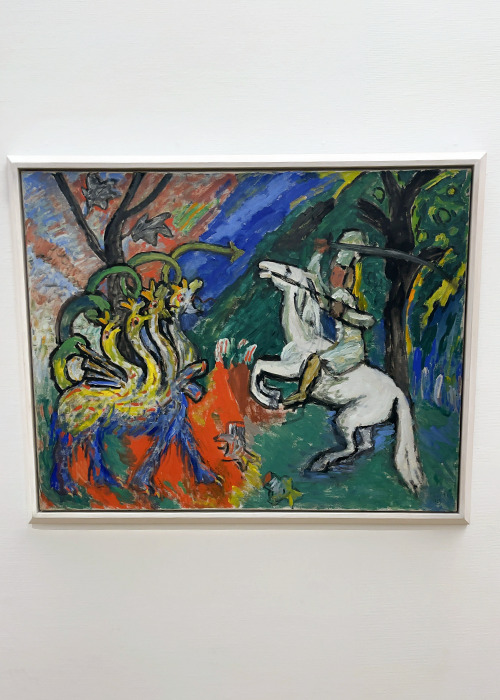
Drachenkampf (Combat du dragon) (1913)
「Drachenkampf (Combat du dragon)」(竜の戦い)は、神話的なテーマを、ミュンター独特の鮮やかな色彩と大胆な筆致で描いています。
ドラゴンと聖ジョージの戦いは、芸術のビジョンを押し付けるアカデミズムへの反発の象徴として描かれています。
Paul Klee (1879-1940)
パウル・クレーは、20世紀のスイスの画家であり、美術理論家でもあります。
- 生涯と活動:
- スイスで生まれ、ミュンヘンで絵画を学びました。
- ワシリー・カンディンスキーらとともに「青騎士(ブラウエ・ライター)」を結成し、表現主義運動に参加しました。
- バウハウスで教鞭をとり、美術理論家としても活躍しました。
- 晩年は、故郷のスイスのベルンにて制作活動を行いました。
- 作風の特徴:
- 子供の絵のような自由な発想と、詩的な表現。
- 線、形、色彩を組み合わせた、独特の抽象的な絵画。
- 音楽、文学、哲学など、様々な分野からの影響。
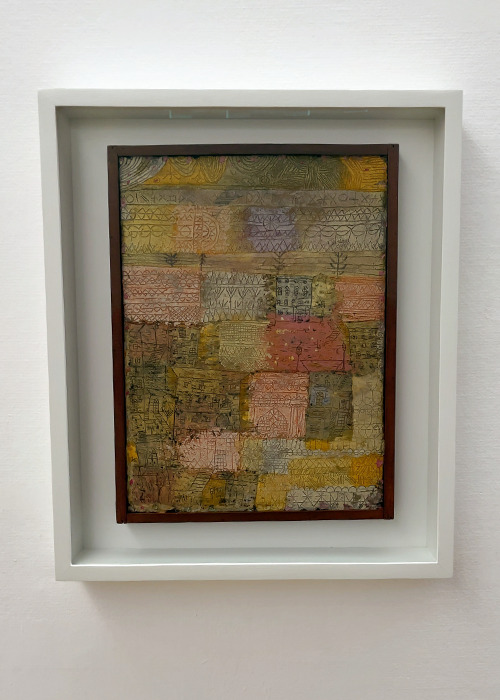
Florentinisches Villen Viertel (Villas florentines) (1926)
「フィレンツェの別荘地」は、クレー独特の幾何学的で詩的な表現で描かれています。
フィレンツェの景観をパッチワークで表現しています。
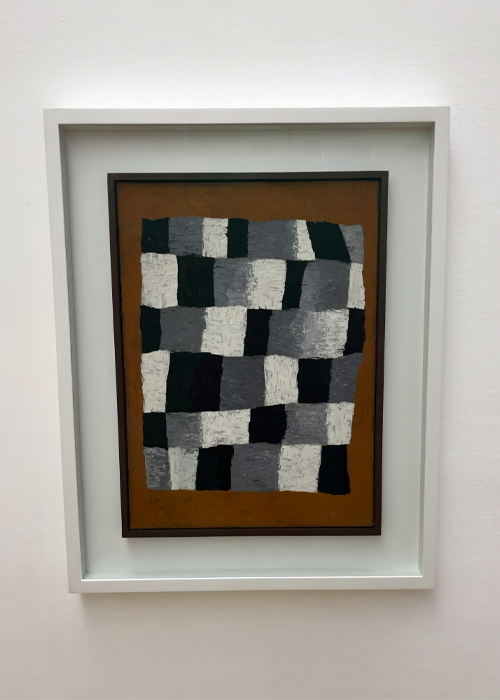
Rhythmisches (En rythme) (1930)
「Rhythmisches (En rythme)」(リズミカルに)は、絵画的な性質を持ちつつ、作曲のコードを取り入れています。
August Macke (1887-1914)
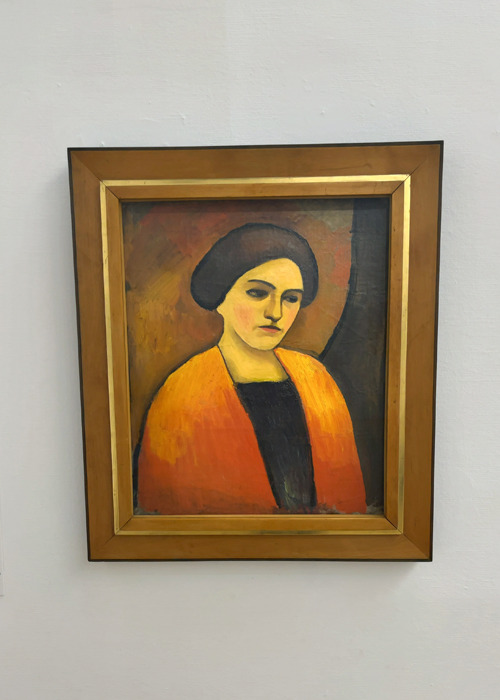
Frauenkopf in Orange und Braun (Tête de femme orange et marron) (1911)
アウグスト・マッケは、20世紀初頭に活動したドイツの画家です。
- 生涯と活動
- ドイツ表現主義の画家であり、「青騎士」(ブラウエ・ライター)のメンバーとして知られています。
- フランツ・マルクとの友情、フランス印象派、フォーヴィスム、キュビスム、そしてイタリア未来派から影響を受けました。
- 第一次世界大戦の勃発後、従軍し、27歳の若さで戦死しました。
- 作風の特徴
- 鮮やかで明るい色彩と、光の表現を重視した作風が特徴です。
- 日常生活の風景や人物を、軽やかで詩的なタッチで描きました。
- 抽象的な要素を取り入れながらも、親しみやすい表現を追求しました。
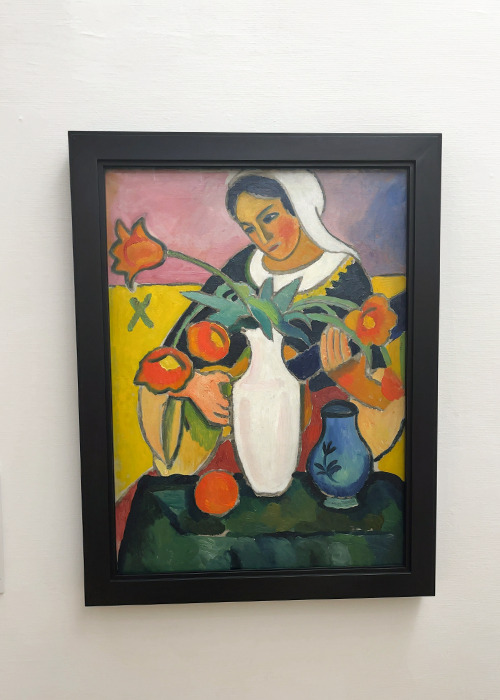
Lautenspielerin (Joueuse de luth) (1910)
「Lautenspielerin (Joueuse de luth)」(リュート奏者)は、1911年、第1回青騎士展に出品された作品です。
背景の装飾的な模様と、女性の衣装の色彩が、画面全体に調和とリズムを与えています。
リュートを奏でる女性の姿を通して、音楽的な響きと、色彩の美しさを表現していると考えられます。
Bauhaus バウハウス
バウハウス(Bauhaus)は、1919年にドイツのワイマールに設立された、美術と工芸、デザイン、建築などを総合的に教育した学校です。20世紀のモダンデザインに大きな影響を与え、わずか14年という短い活動期間でしたが、その理念は現代のデザインにも受け継がれています。
Laszlo Moholy-Nagy (1895-1946)
モホリ=ナジ・ラースローは、ハンガリー出身の画家、写真家、彫刻家、デザイナーであり、バウハウスの教授としても知られています。
第2次世界大戦中にアメリカに亡命し、「ニューバウハウス」を設立するなど、デザインの分野で大きな貢献をしています。
芸術と技術の融合を追求した芸術家であり、その革新的な作品は、現代の芸術とデザインに大きな影響を与えています。
- バウハウスでの活動:
- 1923年から1928年まで、バウハウスで基礎課程と金属工房の指導を行い、バウハウスの教育と制作に大きな影響を与えました。
- 光と動きの実験的な研究を行い、写真、映画、舞台美術など、多岐にわたる分野で革新的な作品を生み出しました。
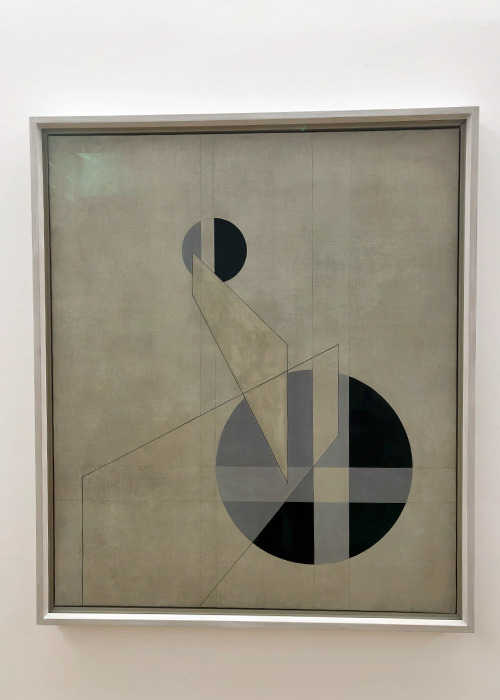
Composition A.XX (1924)
幾何学的な形と、光の反射や透過を意識した透明感のある色彩で構成されています。
光の絵画シリーズの一部として、「私の作品はすべて光の言い換えである。」とナジ自身が言ったように、光の扱い方が際立った作品です。
Futurismo イタリア未来派
イタリア未来派(Futurismo)は、20世紀初頭にイタリアで起こった芸術運動です。詩人フィリッポ・トンマーゾ・マリネッティが1909年に発表した「未来派宣言」をきっかけに始まりました。
未来派の主な特徴
- 伝統の否定:
- 過去の芸術や伝統的な価値観を否定し、新しい時代の芸術を創造しようとしました。
- 機械文明の賛美:
- 自動車、飛行機、機械など、新しいテクノロジーやスピード感、ダイナミズムを芸術に取り入れました。
- 運動と速度の表現:
- 静的な表現ではなく、動きや速度を表現しようとしました。
- 時間の概念を重視し、連続的な動きを表現する技法を用いました。
- 暴力と破壊の肯定:
- 戦争や破壊を、古い社会を破壊し新しい時代を切り開く手段として肯定する過激な思想も持ち合わせていました。
Gino Severini (1883-1966)
ジノ・セヴェリーニは、イタリアの画家であり、未来派の主要メンバーの一人として知られています。
- 未来派への参加:
- 初期には印象派や分割主義の影響を受けましたが、1910年に未来派宣言に署名し、未来派運動に加わりました。
- ウンベルト・ボッチョーニやジャコモ・バッラらとともに、未来派の理論と実践を推進しました。
- 作風の変化:
- 未来派時代には、都市のダイナミズムや動き、速度感を表現する作品を制作しました。
- 第一次世界大戦後には、キュビスムや古典主義の影響を受け、より静的で構成的な作風へと変化しました。
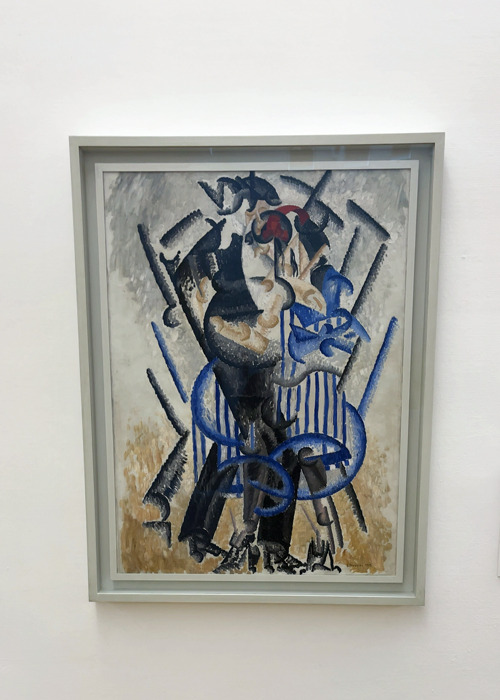
La danse de l’ours au Moulin Rouge (1913)
「La danse de l’ours au Moulin Rouge (1913)」(ムーランルージュでのくまの踊り)は、パリの有名なキャバレー「ムーラン・ルージュ」での熊の踊りを題材にしています。
未来派の理念である動きや速度の表現が、ダイナミックな構図と色彩によって強調されています。
動き(踊り)だけでなく、音楽や匂いなどあらゆるものを表現しています。
Félix Del Marle (1889-1952)
フェリックス・デル・マルルは、フランスの画家・詩人・理論家であり、20世紀初頭の前衛芸術運動に関与した人物です。初期はキュビスムの影響を受け、その後、未来派やダダイスムに傾倒しました。
特に、機械文明や都市のエネルギーに魅了され、力動感あふれる表現を追求しました。
また、ピエール・ル・コルビュジエ(後のル・コルビュジエ)との交流もあり、芸術とテクノロジー、社会との関係に強い関心を持っていました。晩年にはネオ・プラスティシズム(新造形主義)の影響も受け、抽象芸術へと移行していきました。フランス近代美術における多面的な活動家の一人として位置づけられます。
あえて、未来派に分類していますが、本質的には未来派ではないと思われます。
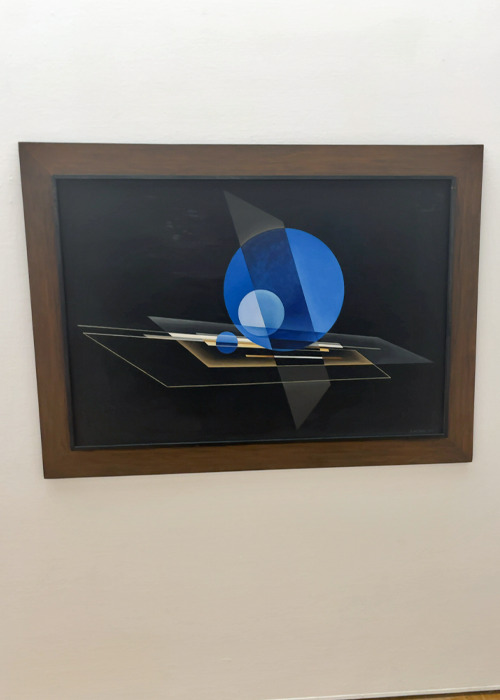
Composition (1947)
幾何学的な形と鮮やかな色彩の組み合わせが特徴です。
Jack of Diamonds & Donkey’s Tail
「ジャック・オブ・ダイヤモンズ」(Jack of Diamonds)と「ドンキー・テール」(Donkey’s Tail)は、20世紀初頭のロシアで活動した前衛芸術家グループの名前です。これらは別々のグループですが、時期やメンバーの重複などから、しばしば関連付けて語られます。
ジャック・オブ・ダイヤモンズ(ブブノヴィ・ヴァレット、Bubnovyj Valet)
- 1910年にモスクワで結成された芸術家グループ。
- ミハイル・ラリオーノフ、ナタリヤ・ゴンチャロワ、ピョートル・コンチャロフスキー、イリヤ・マシコフらが中心メンバー。
- セザンヌやキュビスムの影響を受けつつ、ロシアの民衆芸術やイコン画の要素を取り入れた、力強く大胆な作風が特徴。
- 「ダイヤモンドのジャック」というグループ名は、刑務所の囚人の服にあった模様に由来しています。
- 1912年にグループは分裂し、ラリオーノフとゴンチャロワはグループから離脱しました。
ドンキー・テール(オースリヌイ・フヴォスト、Oslinyj Khvost)
- 1912年にミハイル・ラリオーノフが「ジャック・オブ・ダイヤモンズ」を脱退後に結成したグループ。
- ナタリヤ・ゴンチャロワ、カジミール・マレーヴィチ、ウラジーミル・タトリンらが参加。
- ロシアの民衆芸術や東洋美術の影響を強く受け、より原始的で民族的な表現を追求しました。
- 「ドンキー・テール」というグループ名は、絵画の展覧会にロバの尻尾で描いた絵画を出品したという逸話に由来します。
- ロシア未来主義の先駆けとなるグループでした。
共通点と相違点
- どちらも20世紀初頭のロシア前衛芸術を牽引したグループ。
- メンバーの重複や交流があった。
- 両グループは共に、西洋の前衛芸術とロシアの伝統的な芸術を融合させようとしました。
- 「ジャック・オブ・ダイヤモンズ」はセザンヌやキュビスムの影響が強く、「ドンキー・テール」はロシアの民衆芸術や東洋美術の影響が強いという違いがあります。
- 「ドンキー・テール」は、よりラディカルで実験的な表現を追求しました。
これらのグループは、ロシア・アヴァンギャルドの発展に大きく貢献し、その後の芸術に多大な影響を与えました。
Mikhail F. Larionov (1881-1964)
ミハイル・ラリオーノフは、ロシア帝国(現在のモルドバ)出身の画家であり、ロシア・アヴァンギャルドの重要な人物です。
- 生涯と活動:
- モスクワ美術学校で学び、初期には印象派やポスト印象派の影響を受けました。
- ナタリア・ゴンチャロワと共に、ロシアの民俗芸術やイコン画に影響を受けた「ネオ・プリミティヴィズム」と呼ばれる様式を確立しました。
- 1910年には「ジャック・オブ・ダイヤモンズ」を創設し、ロシア・アヴァンギャルドの発展に貢献しました。
- 1912年には「ドンキー・テール」を創設し、よりラディカルな芸術表現を追求しました。
- 1913年には、ロシア初の抽象絵画運動である「レイヨニスム」(光線主義)を提唱しました。
- 1915年にロシアを離れ、セルゲイ・ディアギレフが主宰するバレエ・リュス(ロシア・バレエ団)の為に舞台美術や、衣装のデザインを担当しました。
- ロシア革命後は後半生をフランスで過ごしました。
- 作風の特徴:
- ロシアの民俗芸術やイコン画の要素を取り入れた、力強く大胆な作風。
- 光の反射や屈折を表現した、抽象的な「レイヨニスム」の創始。
- 舞台美術、衣装デザインなど多岐にわたる芸術活動。
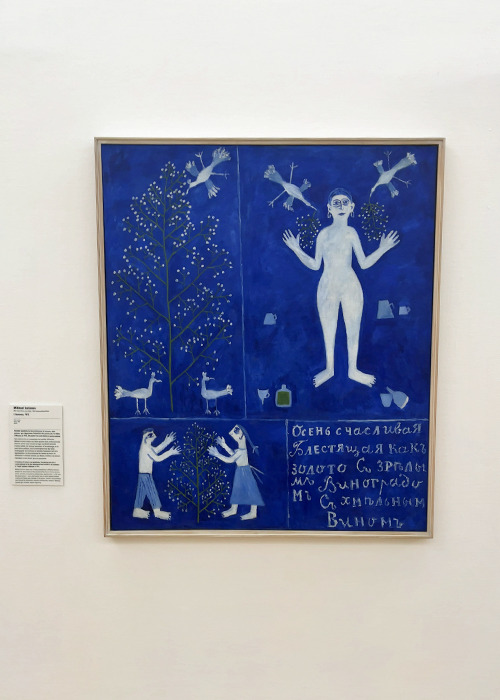
L’automne (1912)
「L’automne (1912)」(秋)は、原始的で民族的な表現を追求しており、色彩と形態の単純化が見られます。 抽象的な要素を取り入れながらも、風景の中に人物が描かれており、具象と抽象の境界を探求していることが伺えます。
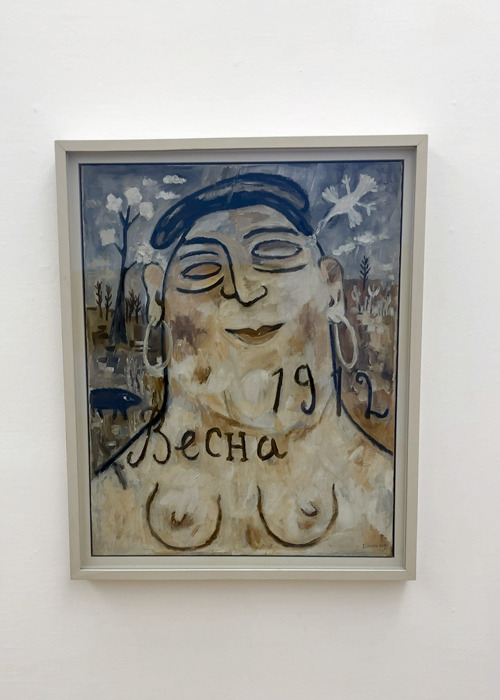
Le printemps (1912)
「Le printemps (1912)」(春)は、春の自然を通して、ロシアの文化や精神性を表現していると考えられます。
ヴィーナス、または異教の女神をパロディとして描くことで、ロシアの体制を侮辱することをためらわない創造の自由を表明しています。
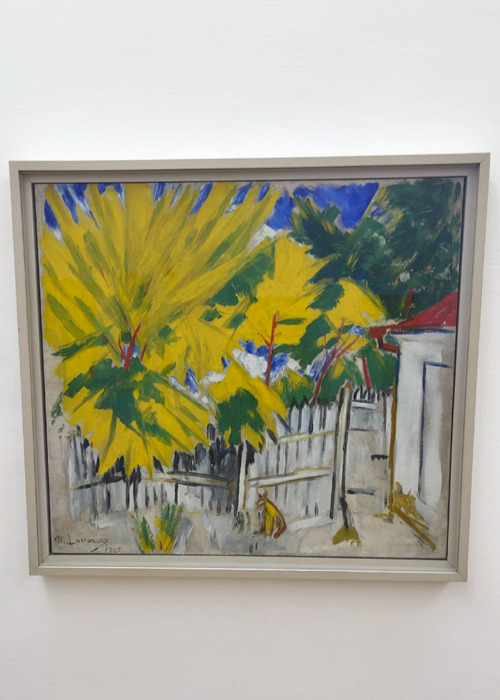
Paysage (1912)
『Paysage(風景)』は、「レイヨニスム(光線主義)」へと向かう過渡期に位置づけられる絵画です。
伝統的な風景が大胆な色彩と装飾的な筆致で描かれており、ラリオーノフ特有のロシア民俗美術や東洋的な感覚が感じられます。
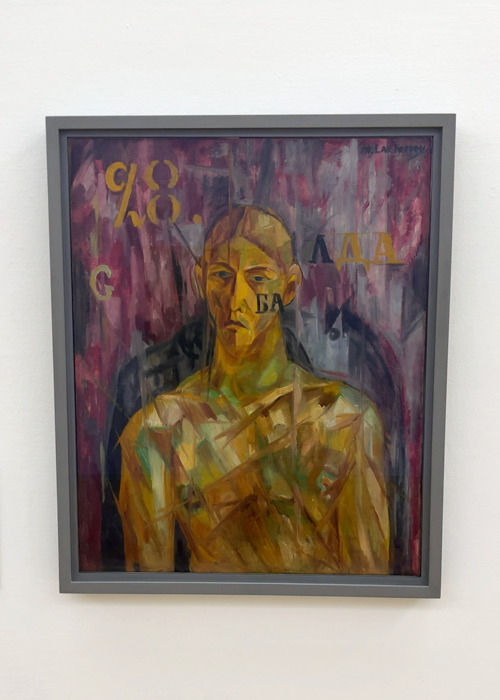
Portrait de V.E. Tatline (1913)
『Portrait de V.E. Tatline(V.E. タトリンの肖像)』は、同時代の芸術家ウラジーミル・タトリンを描いたものです。
この肖像画は、ラリオーノフが提唱した「レイヨニスム(光線主義)」の初期の特徴を示しており、放射状の線や鮮やかな色彩によって、対象(タトリン)を光とエネルギーの流れの中に包み込むように描いています。伝統的な写実的肖像とは異なり、動的で抽象的なスタイルを取り入れることで、タトリンの革新的精神や芸術的エネルギーを象徴的に表現しています。嘲笑する暗示が含まれています。
Natalia Gontcharova (1881-1962)
ナタリヤ・ゴンチャロワは、ロシア帝国(現在のロシア)出身の画家、舞台美術家、衣装デザイナーであり、ロシア・アヴァンギャルドの重要な人物です。
- 生涯と活動
- モスクワ美術学校で学び、ミハイル・ラリオーノフと共に、ロシアの民俗芸術やイコン画に影響を受けた「ネオ・プリミティヴィズム」と呼ばれる様式を確立しました。
- 1910年には「ジャック・オブ・ダイヤモンズ」に参加。
- 1912年にはラリオーノフと共に「ドンキー・テール」に参加。
- ラリオーノフとともに、ロシア初の抽象絵画運動である「レイヨニスム」(光線主義)を提唱しました。
- 1915年以降は、セルゲイ・ディアギレフが主宰するバレエ・リュス(ロシア・バレエ団)のために、舞台美術や衣装のデザインを数多く手がけました。
- 1921年以降は、後半生をパリで過ごしました。
- 作風の特徴
- ロシアの民俗芸術やイコン画の要素を取り入れた、力強く大胆な作風。
- 光の反射や屈折を表現した、抽象的な「レイヨニスム」の創始。
- 舞台美術、衣装デザインなど多岐にわたる芸術活動。
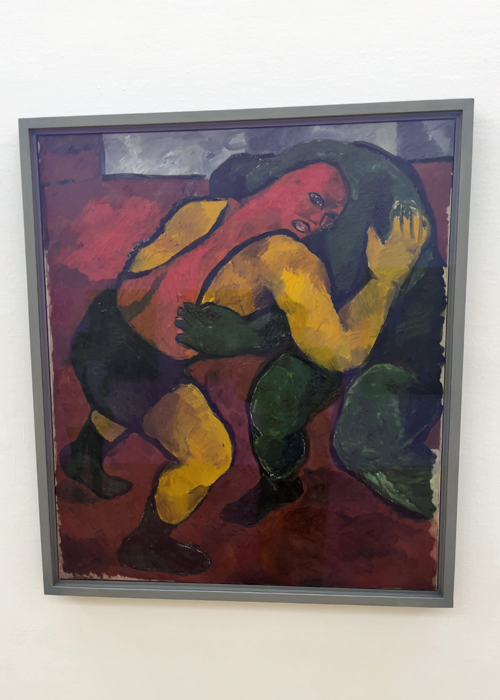
Les lutteurs (1909-10)
『Les lutteurs(レスラーたち)』は、彼女の初期作品の中でも特に力強い表現が見られる作品です。
取っ組み合う男性の肉体が大胆な筆致と鮮やかな色彩で描かれ、フォーヴィスムやポスト印象派の影響を受けながら、動きと力のダイナミズムが強調されています。肉体のボリュームや構図の大胆さから、ゴンチャロワがロシア民俗的なテーマと西欧の前衛技法を融合させていたことがうかがえます。
ゴーギャンの影響を強く受けています。
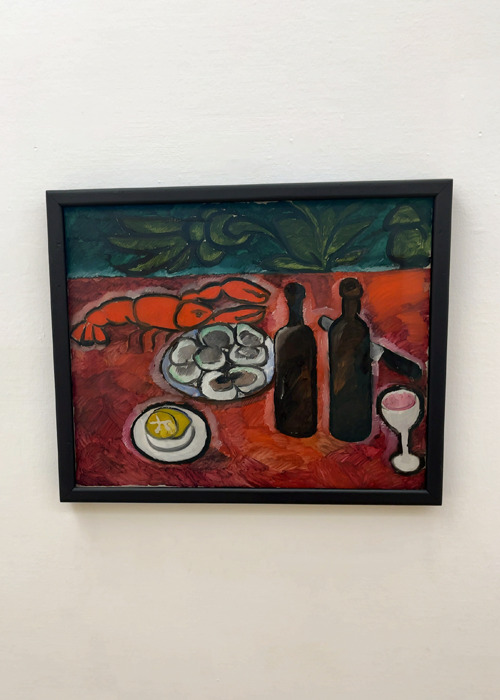
Nature morte au homard (1909-1910)
『Nature morte au homard(ロブスターのある静物)』は、フォーヴィスムやポスト印象派の影響を色濃く反映した作品です。
この絵画では、ロブスターや果物、その他の静物が鮮やかな色彩と大胆な形状で描かれており、伝統的な静物画に対する前衛的アプローチが感じられます。対象を単純化し、色の強調と構造的な要素を使って視覚的なインパクトを与えています。作品全体にエネルギッシュな筆致が見られ、彼女の前衛的なスタイルと新しい表現への挑戦を示しています。
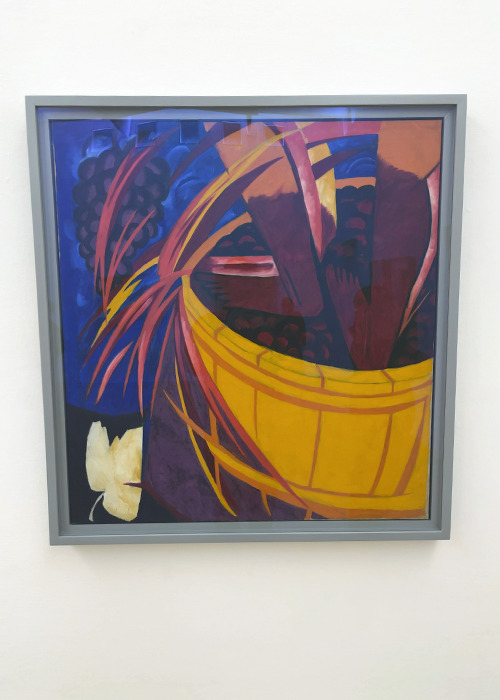
Pieds foulant le raisin (1911)
『Pieds foulant le raisin(ぶどうを踏む足)』(1911年)は、ロシア未来派運動に深く関与していた時期に制作されました。
ブドウを踏む足の動きを見事に表現しています。農作業の力強さと動きが表現されています。
ゴンチャロワは、身体の力強さやダイナミズムを強調し、物理的なエネルギーを抽象的に捉えようとしています。作品には、色彩の鮮やかさと形態の解体が見られ、フォーヴィスムやキュビスム、未来派の影響が色濃く反映されています。
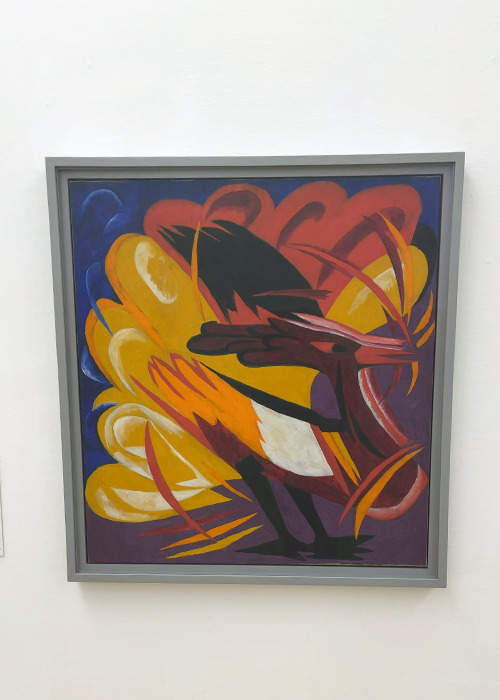
Le Paon (1911)
『Le Paon(孔雀)』初期の未来派的スタイルを示す作品です。孔雀の羽が大胆な色彩と幾何学的な形態で描かれ、動きと力強さが強調されています。孔雀は不死の象徴として描かれています。
孔雀の羽のパターンが力強く描かれ、視覚的にインパクトのある作品となっており、彼女のデザイン的なアプローチと色彩感覚の卓越性が光ります。
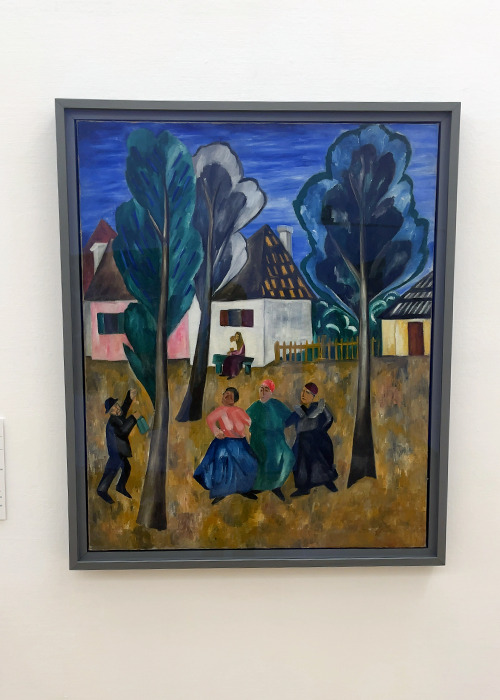
Les ivrognes (1911)
『Les ivrognes(酔っ払い)』は、彼女がロシア未来派運動に関与していた時期の作品です。この作品では、酔っ払っている人物が力強く、ダイナミックに描かれ、エネルギッシュな筆致と前衛的な構図が目立ちます。
ゴンチャロワは、人物の動きや表情を幾何学的に解体し、従来の写実的アプローチを超えて、酔っ払った状態の不安定さやエネルギーを視覚的に表現しています。色彩の鮮やかさと大胆さ、そして動きの強調が、彼女の前衛的なスタイルを象徴する作品です。
『Les ivrognes』は、ゴンチャロワが社会的テーマを取り入れつつ、抽象的な表現を追求した重要な作品となっています。
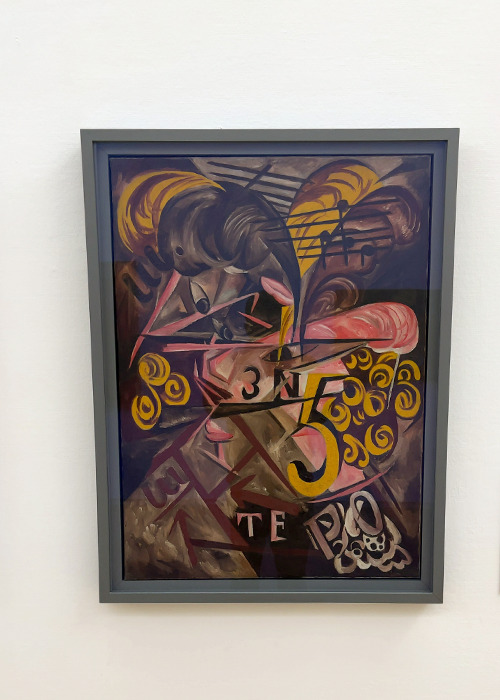
Dame au chapeau (1913)
『Dame au chapeau(帽子をかぶった婦人)』(1913年)は、肖像画で、彼女の前衛的なスタイルを象徴する作品です。この絵画では、女性の顔と姿が力強く抽象化され、色彩や形態が大胆に使用されています。
女性の姿を従来の写実的な肖像画とは異なり、フォーヴィスムやキュビスム影響を受けて、幾何学的な構造と鮮やかな色彩を駆使して描いています。帽子や顔の表現は、形を単純化し、動的でエネルギッシュな印象を与えます。
Constructivism ロシア構成主義
ロシア構成主義(Constructivism)は、1910年代半ばから1930年代初頭にかけて、ロシア(ソビエト連邦)で興った芸術運動です。
主な特徴
- 社会との融合:
- 革命後の新しい社会建設に貢献するため、芸術と産業、社会との融合を目指しました。
- 芸術は、個人の美的欲求を満たすものではなく、社会的な機能を果たすべきであるという考え方。
- 素材の重視:
- 伝統的な絵画や彫刻を否定し、鉄、ガラス、プラスチックなどの工業的な素材を積極的に使用しました。
- 素材の特性を生かした、機能的で合理的な造形を追求しました。
- 幾何学的形態:
- 単純な幾何学的形態を組み合わせた、抽象的な作品が多い。
- 明快で力強い視覚表現を追求しました。
Antoine Pevsner (1884-1962)
アントワーヌ・ペヴスナーは、ロシア帝国(現在のベラルーシ)出身の彫刻家であり、ロシア構成主義の重要な人物です。ロシア構成主義の命名者の一人と言われています。
- 生涯と活動:
- モスクワ美術学校で学び、初期にはキュビスムの影響を受けました。
- 弟のナウム・ガボと共に、ロシア構成主義の理論と実践を推進しました。
- 1920年には、「現実主義宣言」を発表し、構成主義の理念を明確にしました。
- 1923年にロシアを離れ、パリで活動しました。
- 晩年は、フランスで制作活動を続けました。
- 作風の特徴:
- 鉄、真鍮、プラスチックなどの工業的な素材を用いた、抽象的な彫刻作品。
- 空間と時間の概念を重視し、動きや光の表現を追求しました。
- 数学的な計算に基づいて、幾何学的形態を組み合わせた、精緻な構造。
- 評価:
- ロシア構成主義の主要な彫刻家の一人として、20世紀彫刻に大きな影響を与えました。
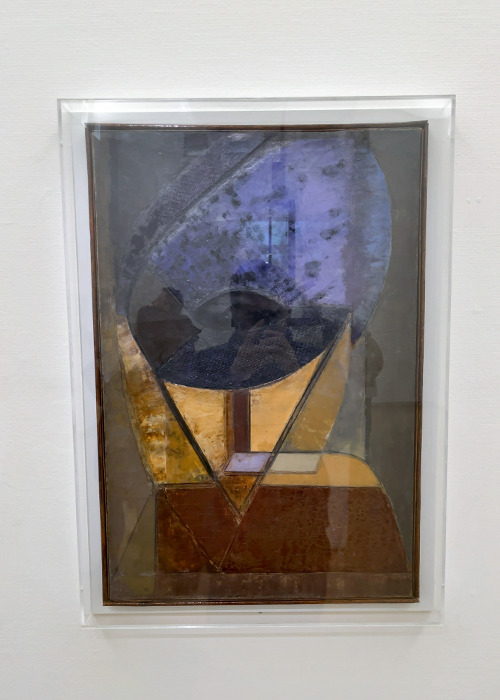
Femme déguisée (1913)
『Femme déguisée(仮装した女)』は、初期の絵画作品の一つで、キュビスムやロシア未来派の影響を受けた表現が特徴です。
この作品では、仮装した女性の姿が幾何学的に解体・再構成されており、動きとフォルムが融合したダイナミックな構図となっています。色彩は抑制されつつも構造的で、視覚的リズムを生み出しています。ペヴスナーは後に彫刻家として知られますが、本作には空間や構造への深い関心がすでに表れており、彼のコンストラクティヴィズムへの道を予感させるものとなっています。
まとめ
今回ご紹介させて頂いた中では、「カンディンスキー」が最も多くの画家に影響を与えています。
抽象画の創始者の一人と言われているカンディンスキーは、ロシア生まれということもあり、時代に翻弄され続けます。
しかし時代に翻弄された続けたからこそ、素晴らしい作品が製作され、その経験が時代へと引き継がれていったのかも知れません。
今回も最後までお読み頂きありがとうございました。
国立近代美術館のコレクションについては以下の記事で詳しくご紹介させて頂いております。合わせてご参照ください。
- ポンピドゥー・センター コレクション|ピカソとシャガール:フランス近代美術の二大巨匠
- 色彩の爆発と造形の革新:フォーヴィスム、キュビスム、オルフィスム – ポンピドゥー・センター・コレクション
- ポンピドゥー・センター:表現主義、青騎士、未来派 – カンディンスキーと革新の絵画
- ポンピドゥー・センター:シュプレマティスム、デ・ステイル、形而上絵画 – 抽象美術の多様性
- ポンピドゥー・センターで見る前衛芸術の衝撃 ダダイスムとシュルレアリスム
- ポンピドゥー・センター:アンフォルメル、タシスム、CoBrA、ヌーヴォー・レアリスム – 戦後美術の多様な展開
- 内面と大衆文化、そして概念の探求:抽象表現主義、ポップアート、コンセプチュアル・アート – ポンピドゥー・センター・コレクション

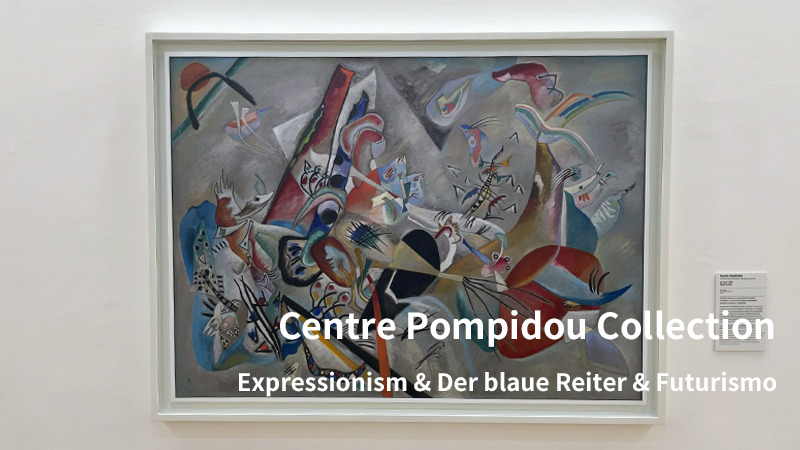


コメント